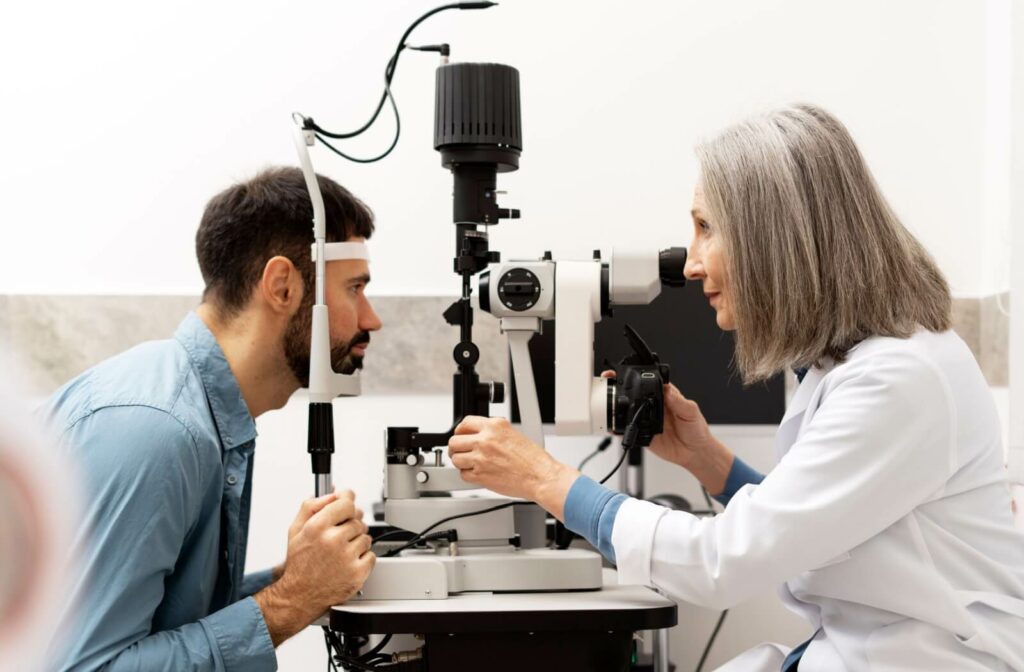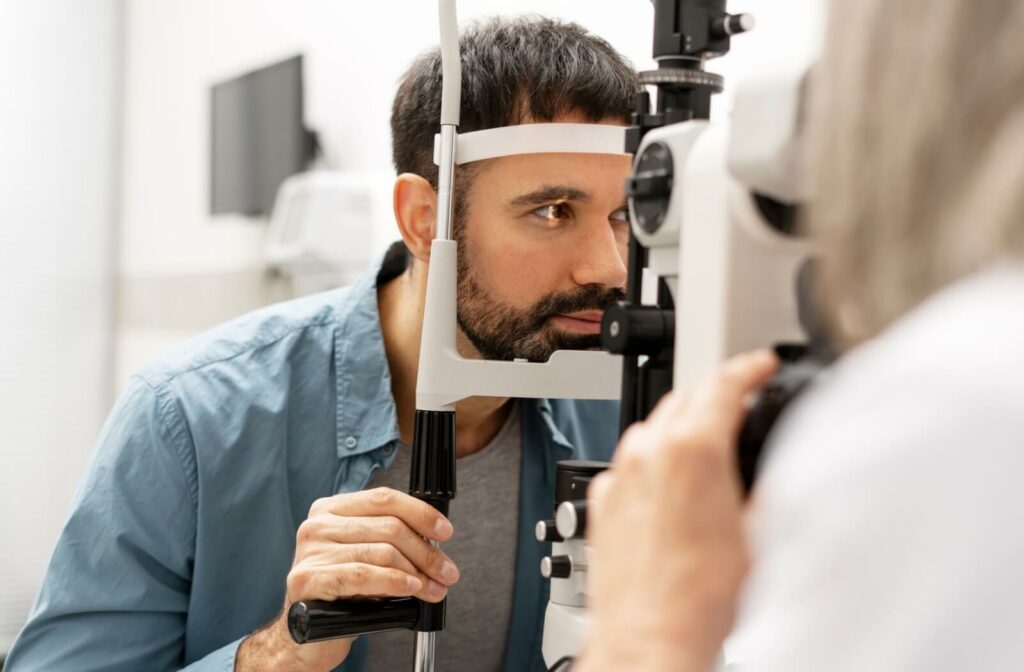Routine eye exams are essential for maintaining clear vision and overall eye health. A standard eye exam typically takes between 20 to 30 minutes, but depending on the type of exam and any specific vision concerns, it may take up to an hour. Understanding what to expect during your appointment can help you feel more prepared and make the most of your time with the optometrist.
At Alaska Eye Care Centers, we provide thorough and personalized eye exams to meet the unique needs of our patients in Anchorage and Wasilla. Whether you’re due for a routine checkup or have specific concerns about your vision, our team is here to help.
What Factors Affect the Length of an Eye Exam?
The time required for an eye exam varies depending on individual circumstances. Here are some key factors that influence how long your appointment might take:
Type of Exam
- Routine Vision Exams: These exams focus on updating prescriptions for glasses or contact lenses. They usually last 20–30 minutes.
- Comprehensive Eye Exams: These exams involve a comprehensive assessment of your eye health and often include additional tests, such as dilation. Expect them to take 20–30 minutes, unless there are complications or dilation is required. Contact lens exams typically add 15–20 minutes to a standard eye exam.
Age Group
- Children: Pediatric eye exams may include developmental assessments, such as checking for lazy eye or other vision issues. These appointments can take slightly longer if additional tests are required.
- Adults and Seniors: Older adults often require more extensive testing to screen for age-related conditions like cataracts, glaucoma, or macular degeneration.
Health History
Your medical history can impact the length of your eye exam. If you have diabetes, high blood pressure, or a family history of eye disease, your optometrist may perform additional tests to check for related complications. Diabetic eye exams, in particular, are billed to medical insurance rather than vision plans
Additional Testing
If you’re experiencing specific symptoms, such as dry eye, double vision, or light sensitivity, your optometrist may perform targeted tests. These can add 10–15 minutes to your visit but are crucial for identifying and addressing the root cause of your concerns.
What to Expect During an Eye Exam
Eye exams typically follow a structured process to ensure a comprehensive evaluation of your vision and eye health. Here’s a step-by-step overview of what happens during your appointment:
Reviewing Your Medical & Vision History
The exam begins with a discussion about your medical history, vision concerns, and any current symptoms. This step usually takes about 5–10 minutes and helps your optometrist tailor the exam to your needs.
Visual Acuity Testing
Using an eye chart, your optometrist or technician will assess how clearly you can see at various distances. This test determines whether you have refractive errors like nearsightedness, farsightedness, or astigmatism.
Refraction Testing
A phoropter or similar device is used to refine your prescription by testing different lens strengths. You’ll look through a series of lenses and indicate which ones provide the clearest vision.
Eye Health Evaluation
Your optometrist will examine the health of your eyes using specialized tools and techniques:
- Slit Lamp Exam: Provides a close-up view of the cornea, iris, and other front structures of the eye.
- Tonometry: Measures intraocular pressure to screen for glaucoma.
- Retinal Exam: Often involves dilation or imaging to check the retina and optic nerve for signs of disease.
Reviewing Results & Recommendations
At the end of the exam, your optometrist will explain their findings, answer any questions, and provide recommendations for corrective lenses, treatment options, or follow-up care.
How Often Should You Get an Eye Exam?
Our practice encourages patients to have an eye exam every year or more frequently if recommended by their optometrist. These guidelines are influenced by factors such as age, overall health, and individual risk factors.
It’s important to note that these are general minimum recommendations. Your optometrist will tailor a schedule that best supports your unique eye health needs. Unless otherwise directed, here is the suggested timeline for eye exams:
- Birth to 2 years: Once between 6–12 months of age
- 3 to 5 years: At least once before starting first grade
- 6 to 17 years: Annually
- 18 to 64 years: Our practice recommends getting annual eye exams
- 65 and older: Annually
Differences Between Glasses & Contact Lens Exams
If you’re getting an eye exam for contact lenses, additional steps are required to ensure a proper fit and optimal comfort. These can include:
- Measuring the curvature of your cornea to determine the correct lens size.
- Assessing your tear film to ensure your eyes produce enough moisture for comfortable lens wear.
- Providing trial lenses to test their fit and clarity before finalizing your prescription.

Why Are Regular Eye Exams Important?
Eye exams do more than just check your vision—they play a vital role in detecting and preventing serious eye conditions. They also allow your optometrist to identify a range of health issues unrelated to your eyes, such as brain tumors, cancer, high blood pressure, and diabetes. These insights make routine eye exams an essential step in maintaining your overall health.
Detecting Eye Diseases
Regular exams can identify early signs of conditions like glaucoma, macular degeneration, and cataracts. Early detection often leads to better treatment outcomes and can prevent permanent vision loss.
Monitoring Systemic Health
Your eyes can reveal signs of systemic conditions like diabetes, high blood pressure, or autoimmune disorders. Eye exams provide an opportunity for early diagnosis and intervention.
Supporting Children’s Vision
Pediatric eye exams ensure that children’s vision supports their learning and development. Untreated vision issues can affect academic performance and overall quality of life.
Preparing for Your Eye Exam
To make your visit as efficient and productive as possible, follow these tips:
- Bring Your Current Eyewear: Whether you wear glasses or contact lenses, bring them to your appointment. This helps your optometrist understand your prescription history and any adjustments that may be needed.
- List Medications: Some medications can impact your vision or eye health. Having a list ready ensures your optometrist has all the information needed for an accurate evaluation.
- Know Your Medical History: Be prepared to discuss your personal and family medical history, especially if there’s a history of eye diseases like glaucoma or macular degeneration.
- Plan for Dilation: If your exam includes dilation, your pupils will be temporarily enlarged, causing light sensitivity and blurry vision. Arrange for transportation if needed.
Frequently Asked Questions About Eye Exams
- How often should I schedule an eye exam? Most adults should have an eye exam annually. However, children, seniors, and individuals with specific eye conditions may require more frequent visits.
- Are eye exams covered by insurance? Many insurance plans cover routine eye exams, but coverage varies. Contact your provider to confirm what is included in your plan before scheduling an appointment.
- Do eye exams hurt? Eye exams are non-invasive and painless. Some procedures, like dilation, may cause mild temporary discomfort.
- Can I drive after my exam? If dilation is part of your exam, your vision may be blurry for a few hours. It’s best to arrange for someone to drive you home.
Technology for Eye Care
Modern eye exams incorporate modern diagnostic tools to provide precise results:
- Digital Retinal Imaging: Captures detailed images of the retina for early detection of issues like diabetic retinopathy.
- Visual Field Testing: Evaluates peripheral vision to detect conditions such as glaucoma.
- Corneal Topography: Maps the cornea’s surface, essential for contact lens fittings and diagnosing keratoconus.
These technologies allow for more accurate diagnoses and effective treatment plans.
Partnering for Your Vision Health
Routine eye exams are a proactive step in maintaining your vision and overall health. Regular checkups help detect changes in your prescription, identify conditions early, and provide peace of mind about your eye health.
At Alaska Eye Care Centers, we’re committed to providing personalized eye care tailored to your needs. With locations in Anchorage and Wasilla, we’re here to help you achieve clear and healthy vision. Book your eye exam today and take the first step toward a healthier you.



